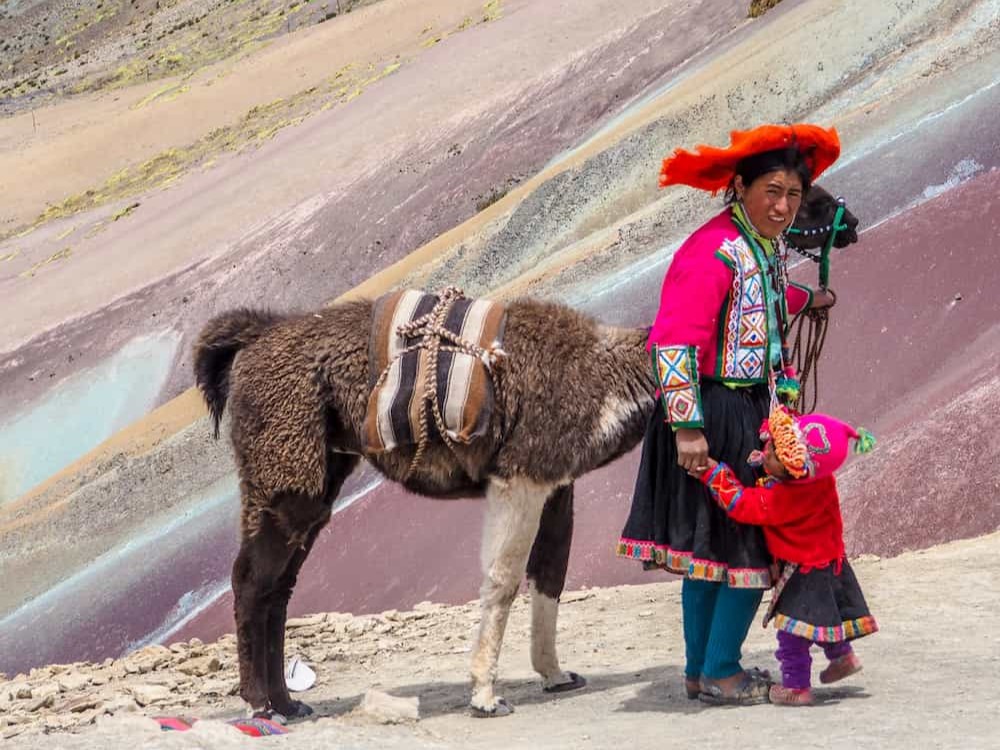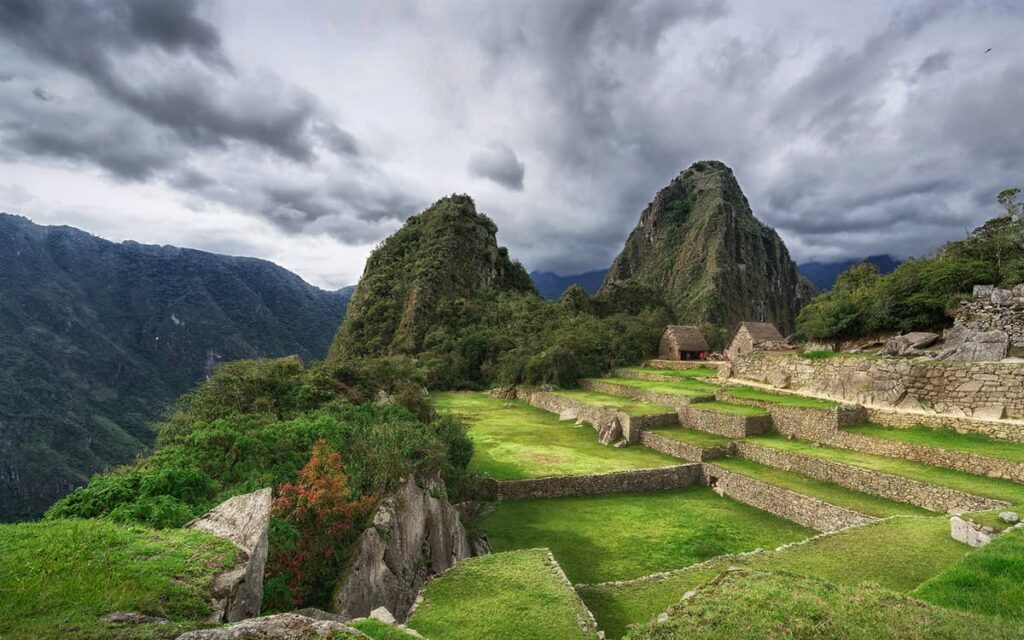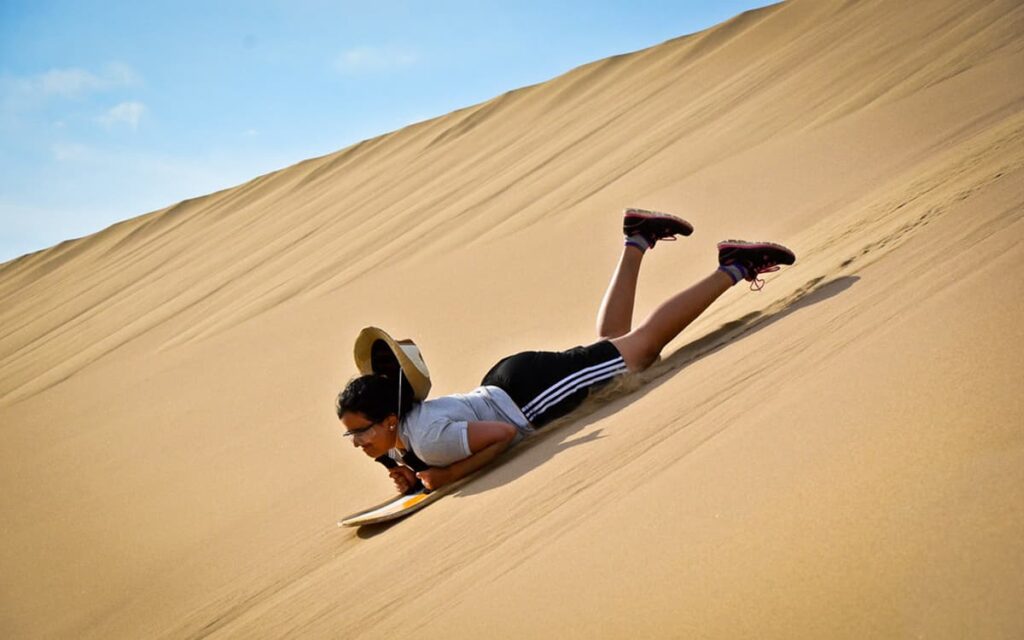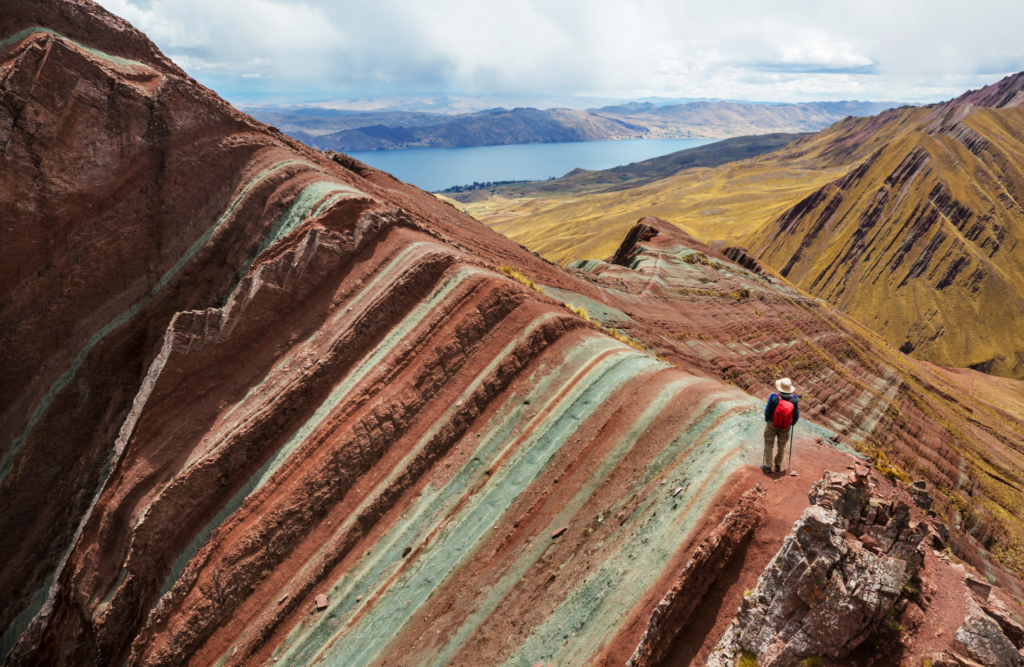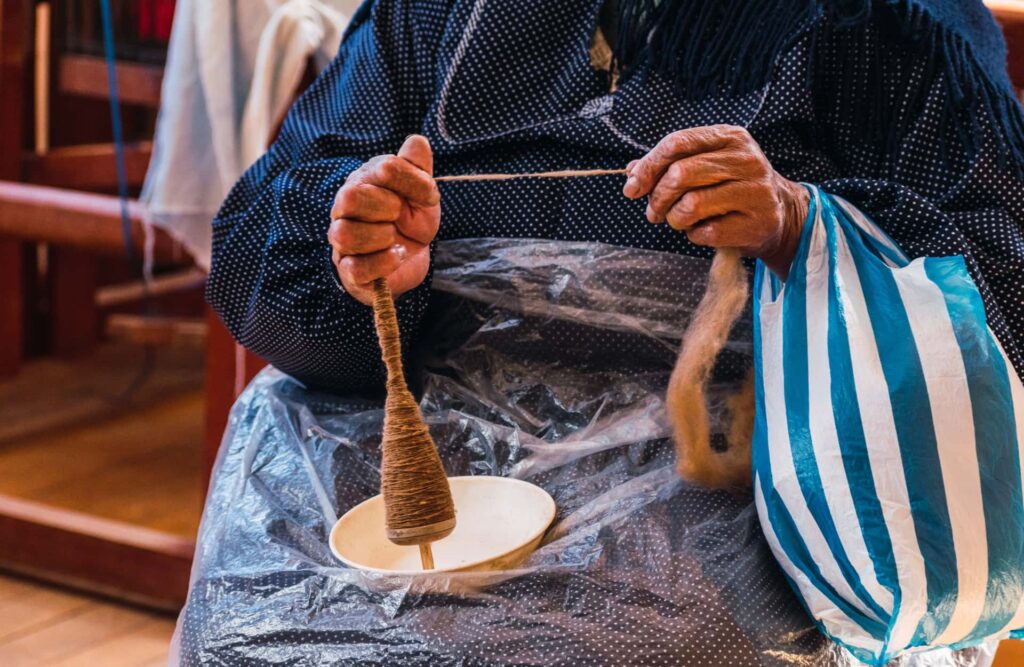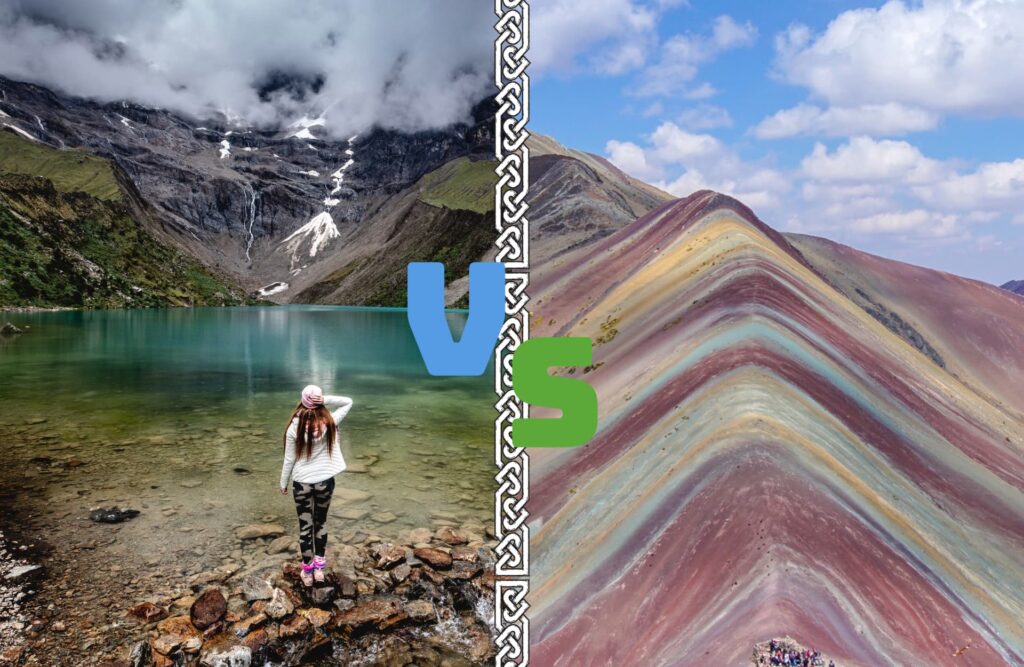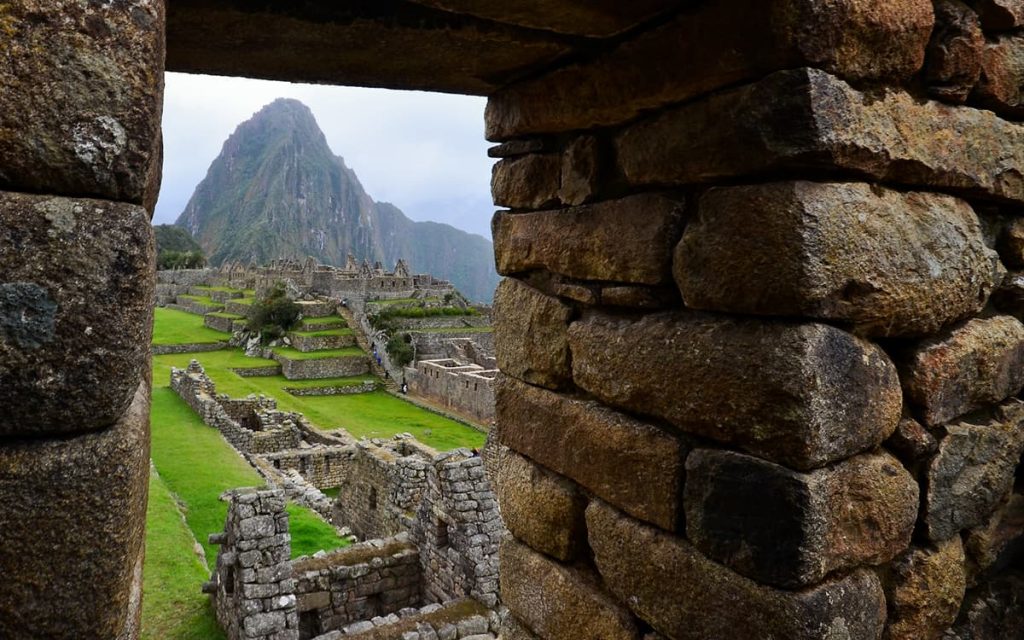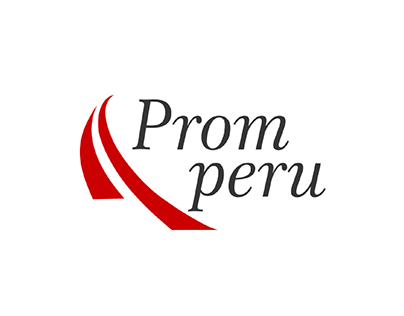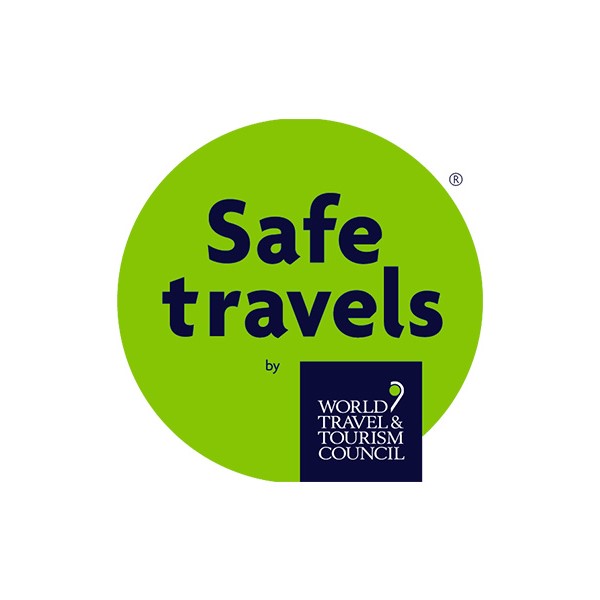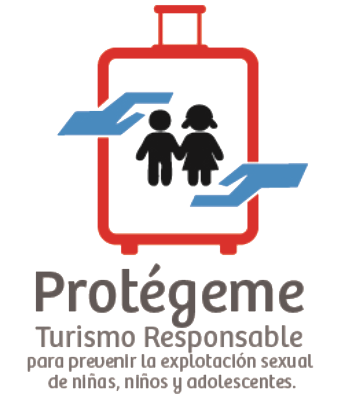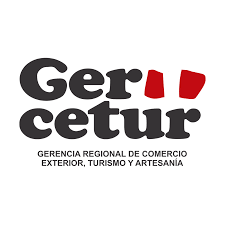What is the Inca Trail and why is it important?
The Inca Trail is a route of 43 kilometers through ancient Inca trails to Machu Picchu. It is important because it is considered the best trek in South America. The duration of the tour is 4 days and 3 nights. Tourists have the opportunity to appreciate the scenic beauty with Inca archaeological sites including the Wonder of the World.
The Inca Trail, also called «Qhapac Ñan» or main road, was a system of roads established by the Inca empire, which traveled more than 30 thousand kilometers through different geographies located in the current countries of Peru, Bolivia, Chile, Argentina, Ecuador and Bolivia.
It should be noted that this immense network of roads is famous for crossing the Andes Mountains, from the mountains of Argentina to the mountains of Colombia, passing through the city of Cusco, the capital of the Inca empire. This route was built using mainly stone.
The Inca roads of the highlands and the coast were joined by transversal sections that, in turn, forked towards other sections that penetrated regions of the jungle. In order to travel these long stretches, the Incas built bridges, tunnels, causeways, walls, stairways as well as deposits (colcas) and shelters (tambos).
The importance of Inca Trail not only lies in its magnitude, since it is the largest monument in America, but in the capacity it had for the effective management of the associated populations, uniting the different regions of the Tawantinsuyu. It included, above all, populations with their own traditions that are still valid today.
In this way, it is a project of enormous importance that unites the Andean populations; integrates social, political, religious and economic aspects; and reinforces the local and regional identity.
The Qhapac ñan road network was declared a World Heritage Site by UNESCO in 2014, after several years of work by the nations of Peru, Bolivia, Chile, Argentina, Ecuador and Colombia. In total, 780 kilometers and 291 archaeological sites were registered. Thanks to this declaration, Inca engineering is recognized worldwide. Likewise, the Inca sections and precincts belonging to this road network are protected and preserved for the future.
Where is Inca Trail located?
The Inca Trail to Machu Picchu is located in the region of Cusco, Peru. The Inca Trail has been divided into several routes and several sections, most of them start from: Km 82, and Km 104 of the Cusco – Ollantaytambo – Machu Picchu Pueblo railway route.
The most important sections of the Inca trail run through slopes, peaks and banks of the Vilcanota river basin.
Description:
The Inca Trail is paved and is between 1.5 to 15 meters wide, it is a central road from which other transversal roads that reached Bolivia, Paraguay, Chile, Argentina, Colombia leave.
The Inca Trail was revealed to the world in 1915 when the Inca City was being excavated. Three decades later, the route was traced by the Viking expedition in 1942. Today, thousands of visitors decide to travel the 43 kilometers to the ‘Puerta del Sol’ in Machu Picchu.
However, Machu Picchu is not the only archaeological site that you will see on the Inca Trail. On the tour you will also appreciate the ruins of Llactapata, the archaeological site of Runkurakay, Saycamarca, Phuyupatamarca and Wiñaywayna.
It is a perfectly designed straight path, with the presence of walls by sectors. The roads that came out of the valley were wider and there were stacks of stones that marked the steepest points between the hills, these sets of stones were called «Apachetas».
The path has steps or spaces built with rough stones, joined with mortar, to avoid muddy areas. Extension: The Inca Trail, both for the entire organization of routes, which exceeded 30,000 kilometers, and for the main road (approximately 5200 km long).
Some information about the tour of the Inca Trail:
- The route crosses archaeological sites such as Llactapata, Runkurakay, Sayacmarca, Phuyupatamarca and Wiñaywayna.
- The end of the road is the entrance to Machu Picchu through the Intipunku (Puerta del Sol). That was the main gate in the time of the Incas. The scenery there is incredible.
- In most cases, after traveling the Inca Trail, you will return to Cusco by train.
- Some people decide to stay and relax in the hot springs of Aguas Calientes to return to Cusco the next day.
History of the Inca Trail:
The Incas stood out for their engineering works and especially for the road network. There were two main roads from north to south, one along the coast and the other through the highlands. They were crossed by cross roads and secondary roads that linked all the villages and towns. The main road started from Tumbes, passed to Arequipa and Chile. The longest communication route started from Colombia, continued to Cuzco, continued to Ayavire where it forked into two branches that surrounded Lake Titicaca, continued southeast to Tucumán, Argentina. From there a branch started that reached Coquimbo, Chile, continuing from there to present-day Santiago. Another branch ended in the current Mendoza valley of Uspallata. To this place the Incas transferred populations of quantity of mitimas. It is considered true that the construction of the current ditches is due to Inca influence. These roads were paved with stone slab and measured between 4.5 and 6 meters, they are 1 and 2 meters high. In the coastal area, the roads were straight and where it was impossible to do them.
A territory as extensive as the Tahuantinsuyo, needed to unite, at all times, its various areas and this was understood very well by the Inca rulers who arranged the construction of roads based on the roads already built by Andean cultures prior to the Incas, for example the Moche, Huari, Tiahuanaco and Chimu who covered large areas and therefore must have had efficient road networks According to historian Victor von Magen, while Europeans traveled through muddy and muddy paths, Peruvians were already walking along roads that had no resemblance elsewhere, there was nothing in Europe or Asia that could serve as a comparison. Main roads According to the history of the Inca Trail, the main roads of the Incas were two: the roads of the Sierra and those of the Coast that went in parallel, these were the road pillars of the Inca communications and were linked in a transversal way to communicate to the Andean regions.
Who built the Inca Trail?
The famous emperor Pachacutec (1400 – 1471) was the one who initiated the Inca expansionist process as well as the construction of the main sections of Inca Trail for new conquered territory.
The successor Inca emperors continued with the expansion of the Inca Trail as well as the construction of bridges, warehouses and shelters along the roads.
When was the Inca Trail built?
Built in the 15th century, between 1438 and 1533, when Tahuantinsuyo was the dominant empire in pre-Columbian America, the roads were built high up to accommodate the local pack animal, the llama.
Who used the Inca Trail?
This network of roads was very essential in Inca times as it served to move armies and officials, displacement of the Chaskis, and so much so to transport food products that had to go to the city of Cusco.
What was the Inca Trail used for?
The main function of the Inca Trail was to communicate the city of Cusco, the center of Inca power, with the rest of the provinces of the empire. Likewise, because the roads were built during the expansionist era, they fulfilled a function of political, administrative, cultural and social domination of the recently conquered peoples.
The path in the Andes
From Cuzco, passed through Huancavelica, Ayacucho, Huanuco, Cajamarca and reached Quito, extending to Colombia.
The coastal path
It also started from Cuzco and went down to the coast near Nazca, and from there it continued through the ancient territory of the Paracas, Chincha, Pachacamac, Rimac culture, as far as Tumbes, also reaching the city of Quito.
The bridges
Various types of bridges made it possible to cross rivers. According to the history of the Inca Trail, in the mountains there were bridges made of tree trunks when the distances were not great and those who became famous for their ingenuity were what the Spanish called «criznejas». These bridges rested on two large stone abutments with strong and solid foundations and between each abutment there were four or six thick girders that tied the suspension bridge. The ropes were woven from branches thin as wicker, twisting three by three to thicker ones and the branches were increased until they reached a diameter of about fifty centimeters.
Why hike the Inca Trail?
Although we have many options or ways to get to Machu Picchu, there is a route that is the most preferred among travelers, we refer to the Inca Trail tour, this excursion covers approximately 42 km. Walking for 4 days is a real sacrifice, for that reason, here are enough reasons why do the Inca Trail, classified as the most famous walk in South America and one of the most important in the world.
Reasons to hike the Inca Trail
1. Know one of the seven wonders of the world «Machu Picchu»
Reaching Machu Picchu after 4 days of walking is a tremendous experience, this world wonder is located on the top of a mountain, it has squares, temples, roads, stairways, terraces and aqueducts, constructions that show how imposing the city was. Inca culture and without a doubt it is a destination that leaves everyone who visits it breathless.
2. Be in contact with local people
By doing the Inca Trail you will be able to live this experience, you will be able to socialize with the local people and share unforgettable moments, most of the journey will be accompanied by an authorized guide, porters, muleteers among others, in this way, you will be able to live together, learn about their culture, their customs and their life.
3. Live the best adventure of your life
The adventure experienced during this excursion is incomparable, throughout the entire journey of the Inca Trail you will be surrounded by stone paths, archaeological monuments, sacred mountains, inter-Andean valleys, the jungle and landscapes that you will never see.
4. Enjoy natural beauty and Andean culture
When doing the Inca Trail, you will be able to visit little-known archaeological monuments, observe the natural beauty, breathe the purified open air of native plants, hear every noise of nature, step on each cobblestone of the path and above all soak up the local culture through of their stories.
5. Meet people from different countries
The Inca Trail is an excursion that gives you the opportunity to meet people of different nationalities, different cultures and religions all with the same purpose to reach Machu Picchu, the experiences, sharing anecdotes and making friends also make it one more reason why choose this trek on your next trip.
6. Watch the sunrise from Inti Punku
One of the important reasons also for choosing this excursion is to be able to observe the sunrise from Inti Punku, this event is unforgettable because it allows you to witness how the first rays of the sun pass through the early morning mist and illuminate the sky above the wonder of the world, also appreciating Machu Picchu from the top of this mountain has no comparison.
7. Get to know new archaeological centers
Along the way you will be able to visit remote and little known archaeological centers, these attractions represent the Inca culture and remain alive through the years, so we can find Patallacta, Runkuraqay, Sayacmarca, Phuyupatamarca and Wiñaywayna.
8. Put your body to the test
Performing the Inca Trail is not easy, it is a demanding walk that many travelers describe as a challenge, it requires having good physical condition and prior preparation, without a doubt a challenge that tests your body and mind.
Is Inca Trail worth it?
YES! It is worth hiking the Inca Trail. It is a path that leaves a mark. Machu Picchu is a unique place and that is why it is one of the wonders of the modern world, but reaching it with effort makes the experience absolutely round. What’s more, when you arrive after 4 days walking you feel adventurous.
There are two ways to get to Machu Picchu, sweating or not, there are no more options. You can experience it as a reward or as an excursion. It is definitely worth arriving sweating the shirt.
Landscape:
The surroundings are impressive and the balance achieved between nature and Inca architecture is amazing. The mountains of Vilcabamba have wide and high peaks that reach up to 6,000 meters as well as Salkantay and Humantay among others. The mixture of mountains, jungles and valleys create a fantastic world where dawn and sunset are shrouded in mystery.
Archeology:
Apart from all that has been mentioned, there is also the cultural heritage of the Incas. The Way of the Inca, which was well built, crosses dense forests and deep canyons. There are 18 archaeological complexes scattered along the route that can be seen in all its splendor. These are composed of houses, irrigation channels, construction of agricultural terraces, walls and altars, which are irrefutable evidence of the existence of important human settlements.Here the most important:
- Ollantaytambo: Ollantaytambo is a small town near Cusco and where we will find a construction left by the Incas. During the time of the Inca Empire, Ollantaytambo was a real property and when the Spaniards were in their conquest of what is now Peru, it was a bastion of Inca resistance. There is a train station from where you can get to Aguas Calientes and from there to Machu Picchu.
- Canabamba: It was a small administrative control point left by the Incas.
- Llactapata / Llaqtapata: Llactapata means City on top, it was a small Inca city and now one of the very popular Inca archaeological sites along the Inca Trail.
- Wilka Rakay: It is an Inca ruin over Llactapata that was used as a checkpoint.
- Wayllabamba: It is also a ‘llacta’ or administrative center of the Incas, besides being a small city with the same name in the area.
- Yuncachimpa: Yuncachimpa is a small rest area with restrooms and a place where you can buy supplies along the Inca Trail.
- Llulluchapampa: Llulluchapampa is the last place on the Inca Trail where you can buy supplies before arriving at Machu Picchu.
- Dead Woman Pass: The Dead Woman Pass, a Quechua name known as Warmiwañusqa, is named because the mountain looks like the profile of a woman looking at the sky.
- Paccaymayu: Paccaymayu is one of the camps along the Inca Trail at 3500 meters and this is also the name of the Paccaymayu Valley.
- Runkuraqhay: Runkuraqhay is an archaeological construction that is believed to be an administrative point left by the Incas.
- Runkuraqhay Pass: Runkuraqhay Pass, named for the mountain and the ruins of the same name. From this height, you can see the valley that you just left and the one in front of you along the Inca Trail. This is a great point of view and a place to take pictures. It is northeast of the ruins of Sayacmarka.
- Sayacmarka: Sayacmarka is an Inca ruin that is believed to be a village, as well as a sacred area, dedicated to the mountains. Sayacmarka means’ place where you can not enter / inaccessible.
- Chakiccocha: Chakiccocha means ‘dry lake’ and is one of the campsites along the Inca Trail.
- Phuyupatamarka: Phuyupatamarka is a point of view and an archaeological center. It is believed to be a Llacta or administrative center for the Incas.
- Inti Pata: It was believed that Inti Pata was used as an agricultural center by the Incas.
- Wiñayhuayna: Wiñayhuayna means ‘always young’ and is considered a sacred place along the Inca Trail trip before reaching Machu Picchu.
- Intipunku: Intipunku is also called ‘Sun Gate’ and leads to Machu Picchu. This is a great point of view from where you will get your first view of Machu Picchu. It was used by the Incas during their ceremonies for the summer solstice in December.
Inca Trail Routes
The Inca Trail is considered the best trek in South America. Tourists have the opportunity to appreciate the scenic beauty with Inca archaeological sites including the Wonder of the World.
The Inca Trail Route shows rugged geographies with ascents and descents next to cliffs. Mountains reach great heights with rugged stretches. In the jungle areas you will see the variety of shades of green the tropical forests.
Not all people have the necessary days to travel the classic Inca Trail (4 days and 3 nights). That is why there are 2 versions depending on the time available:
- Classic Inca Trail: 4 days and 3 nights.
- Short Inca Trail: 2 days and 1 night.
INCA TRAIL 4 DAYS ITINERARY:
DAY 1: CUSCO -WAYLLABAMBA
Very early in the morning we pick you up from your hotel in the mobility that will take us to kilometer 82, where we will arrive to then start the walk. This first day is beautiful and the first kilometers are easy to walk. We will have a beautiful view of La Veronica and we will also walk close to the Vilcanota River until we reach the archaeological complex of Llactapata, where we will have lunch and then continue to our first camp in Wayllabamba where we will spend the night after a refreshing dinner.
Day 2: WAYLLABAMBA- WARMIWAÑUSCA PASS – PACAYMAYO
After a comforting breakfast, we will start our second day of trekking, perhaps the most difficult, since we will have to climb up to the Warmihuañusca pass, at 4,200 meters above sea level. In this place, the highest point of the Inka Trail, we will be able to enjoy a panoramic view of the snowy mountains that surround the pass. After lunch begins the descent to the valley of Pacaymayo, where we will make our second camp
Day 3: PACAYMAYO – RUNQURAKAY – SAYACMARCA- PHUYUPATAMARCA – WIÑAYHUAYNA
In the early morning after our energetic breakfast again we take the road again. Started the march, half an hour later we will find the archaeological group of Runqurakay. From this point the path is paved. In certain places it reaches up to 2 meters. Wide and you can see the quality of Inca engineering. We will visit Sayacmarca, a beautiful architectural complex; We will pass through a tunnel, dug in the stone of the mountain, to reach the archaeological group of Phuyupatamarka, from where the descent begins along an extremely attractive path, with dense vegetation of the eyebrow of the forest, very rich in flora and fauna. After two we will arrive at Wiñayhuayna, where we will install our third and last camp.
Day 4: WIÑAYHUAYNA – SUN GATE – MACHU PICCHU
The big day has arrived !!! After breakfast we will continue the walk until we reach Intipunku (Sun Gate) from where we will have a spectacular view of the sunrise in the lost city of the Incas «Machu Picchu», descend for 01 hour, then we will have a guided tour for 2 hours of the most important recint, then you can explore the mysterious city at your own pace or hike the Huayna Picchu Mountain (optional and extra cost) We take the bus to the town of Aguas Calientes and Finally we will return to the city of Cusco.
Inca Trail Map:

INCLUDED:
- Bus until kilometer 82 start of the walk.
- Bus tickets going down from Machu Picchu to Aguas Calientes.
- Entrance tickets to the Inca Trail and Machupicchu.
- Tourist train ticket from Aguas Calientes to Ollantaytambo.
- Transfer from Ollantaytambo to Cusco.
- Tent (four person tent).
- Mattress
- Porters (only for tents, lunch and camping equipment).
- First aid kit, oxygen ball.
- Food 3 Breakfasts, 3 Lunches and 3 Dinners, Vegetarian option (no extra charge).
- All the taxes.
NOT INCLUDED:
- Tips
- Food
- Sleeping
- Entrance to Huayna Picchu Mountain or Machupicchu Mountain
- Entrance to Manuel Chavez Ballon Museum
- The first breakfast (first day) is usually provided at your hotel before leaving.
- The last lunch (fourth day) when the tour ends.
Which Inca Trail tour is the best?
Not all people have the necessary days to travel the Inca Trail (4 days and 3 nights). That is why there are 2 versions depending on the time available:
- Classic Inca Trail: 4 days and 3 nights (43 kilometers of walking).
- Short Inca Trail: 2 days and 1 night (12 kilometers of walking).
While the Classic Inca Trail 4 days is more popular and offers you the possibility to see more inca´s constructions, the short route also offers an unforgettable experience with less effort.
Therefore, to choose which is the best Inca Trail tour for you, you must take into account various aspects such as your travel time, budget and physical condition.
Here we show you the differences between the Inca Trail 4 days and the Short Inca Trail:
Inca Trail 4 days or 2 days
| Classic Inca Trail 4D/3N | Short Inca Trail 2D/1N | |
| Duration: | The classic route is four days. | The Short Inca Trail is two days long. |
| Attractions: | The Classic Inca Trail 4 days route includes the following attractions: – Archaeological Group of Patabamba – Wayllabamba Ruins – Warmihuañusca, the highest point of the route. – Pacamayo, resting place. – Runncurakay Archaeological Site – Sayaqmarca Ruins – Archaeological Site of Wiñay Huayna – Inti Punku | The Short Inca Trail route includes the following attractions: – Archaeological Site of Wiñay Huayna – Inti Punku |
| Physical effort: | The Classic Inca Trail tours lasts four days and goes through landscapes that go from low fertile valleys to the Warmihuañusca pass at more than 4000 meters of altitude. The first days of the route have steep stretches that are a physical challenge for many. | The 2-day route is lighter since you only walk during the first day. This route is more suitable for those who have little time or are beginners in trekking. |
| Accommodation: | In the Classic Inca Trail tours, night camps are carried out on the route for the first three days. You just have to bring your sleeping bag and the rest of the equipment is provided by the travel agency. | Unlike the long route, during the Short Inca Trail, the night is spent at the hotel of your choice in the town of Aguas Calientes. |
| Tickets availability: | The Inca Trail tours 4 days admits up to 500 people a day, including guides and service personnel. Spaces are usually sold quickly so it is best to buy them at least 6 months in advance. | The Short Inca Trail route only admits 250 people. This route is new and not very popular so it is more available. |
inca Trail with hotels
The only Inca Trail route that includes a night in one of the heteles of Aguas Calientes is the 2-day Short Inca Trail.
The short Inca trail is easy. It only travels approximately 11 kilometers. The first part is uphill so it is the most difficult. Once at the archaeological site of Wiñay Huayna, the path becomes easier. The entrance to Machu Picchu, like the Classic Inca Trail, is through Puerta del Sol.
After arriving at the citadel of Machu Picchu, tourists will go down to the town of Machu Picchu or Aguas Calientes, where they will spend the night in one of the hotels in the area.
The next day, tourists will take a bus up to the citadel of Machu Picchu, finally they will get to know the Inca City with their tour guide. The return is by train and bus to the city of Cusco.
inca Trail with Lodges
On the other hand, during the Inca Trail 4 days, tourists will rest in the different lodgess implemented.
On the way from the Inca Trail to Machu Picchu hike, there are camping areas, duly marked, codified, indicated and delimited.
They are the Meskay, Hatunchaca, Wallabamba, Ayapata, Llulluchapampa, Pacaymayu, Choquicocha, Phuyupatamarca and Wiñay Huayna camps.
The Travel Agencies cannot set up their lodges, in places NOT marked, it would not be safe for the group and the place would be predated.
Along the way, there are basic toilet services for public use and they are duly signposted. In the camps you can find basic toilet services. And in the last camp you can find basic showers.
In the camping areas, you do not have electricity or a cell phone network, so it is recommended that you take appropriate precautions. Take a personal flashlight, charge your batteries in advance and be ready, to enjoy a starry sky and depending on the day you will have the light of the full moon.
The camping areas are permanently protected by the guards, you will be safe, without annoying noise. The surveillance staff will be in charge of controlling any risk that may arise.
In the lodges, remember that there should be no trace, of your passage, do not leave traces of your stay, all garbage must be delivered to the agency staff, have your own garbage bag and at the end of the walk, hand it over; The support staff will be in charge of selecting organic and inorganic solid waste and removing it from the Inca Trail.
Do not step on mosses, they die quickly, do not tear off flowers, leaves, branches, etc. If an animal visits you, do not approach it, do not disturb it, observe from afar and thank you for the good luck of seeing it.
Do not leave food residues, scattered, on the floor, apart from dirtying the camping site, it can alter the natural diet of wildlife.
If you find any waste that has been left by someone else, please pick it up and deliver it to the agency staff, it will be an action that all walkers will thank you for, because you will be collaborating, with the maintenance of the Inca Trail to Machu Picchu, will be an activist to avoid, the environmental impact, in this natural and historical cultural attraction.
- The first lodge is in Ayapata (3,000 masl), 14 kilometers from Km 82, where dinner will be prepared and the night is spent in tents or tents, with a spectacular view of the Andean mountains, against the totally calm sky. integrated with nature.
- The second lodge is in Choquicocha (3600 masl), 16 kilometers from Ayapata, with spectacular views of the Peruvian Andes, where we will have dinner and spend the night in tents or tents. This Camp is one of the most picturesque yet frigid, with a fantastic view of the night sky for stargazing.
- The third lodge is in Wiñay Huayna (3680 masl), 10 kilometers from Choquicocha, this camp is the most exciting of all the above because we will be only 4 kilometers from Puerta del Sol, this means that we will prepare for An early walk before sunrise and we will observe the sunrise through the Inti Punku. Although because it is an exclusive place, it cannot be said with certainty that we will camp in this place.
Where does the Inca Trail start and end?
Depending on the Inca Trail route you decide to walk, each one has a different starting point, on the other hand, both routes end at Machu Picchu.
The Inca Trail 4 days begins at kilometer 82 of the railway that leads to Machu Picchu (2 hours and 30 minutes by bus from the city of Cusco).
Meanwhile, the Inca Trail 2 days begins at kilometer 104 of the railway that leads to Machu Picchu (2 hours by bus from Cusco + 1 hour and 30 minutes by train).
Machu Picchu is the end point of this amazing tour.
This hiking trail is the most amazing way to get your first view of the Wonder of the World, just as the Incas did almost 600 years ago.
How long is the Inca Trail to Machu Picchu?
Each of the Inca Trail routes has a different distance:
- Classic Inca Trail length: 39.6 kilometers.
- Short Inca Trail length: 11 kilometers.
Below we detail the distance of each of the Inca Trail routes:
Inca Trail 4 days and 3 nights Length:
- Duration: 4 days
- Total Inca Trail length: 39.6 Km / 24.6 miles
- Starting point of the trek: Km 82
- Arrival point of the trek: Machu Picchu (Day 4)
- Accommodation: 3 camps
- Difficulty: Medium
Inca Trail 4 days Length day by day:
| Day | Total walking distance | Total duration of the walk | Maximum altitude |
| Day 1 | Km 82 – Wayllabamba: 13 kilometers | 6 hours aproxximately | 3,100 masl / 10,170 ft |
| Day 2 | Wayllabamba – Pacaymayo: 11 kilometers | 7 hours aproxximately | 4,224 masl / 13,858 ft |
| Day 3 | Pacaymayo – Wiñay Huayna: 16 kilometers | 10 hours aproxximately | 3,725 masl / 12,221 ft |
| Day 4 | Wiñay Huayna – Machu Picchu: 5 kilometers | 2 hours aproxximately | 2,650 masl / 8,694 ft |
| Total | 45 kilometers | 25 hours aproxximately |
Inca Trail 2 days and 1 night Length:
- Duration: 2 days
- Total Inca Trail length: 11 km / 6.14 miles
- Starting point of the trek: Km 104
- Arrival point of the trek: Aguas Calientes (Day 1)
- Accommodation: 1 camp or hotel (Aguas Calientes)
- Difficulty: Easy
Inca Trail 2 days Length day by day:
| Day | Total walking distance | Total duration of the walk | Maximum altitude |
| Day 1 | Km 104 – Aguas Calientes: 12 kilometers | 6 hours aproxximately | 2,650 masl / 8,694 ft |
| Total | 12 kilometers | 6 hours aproxximately |
Altitude in the Inca Trail
The Inca Trail is considered a difficult expedition not only because of the distance but also because of the high altitude at some point along the way. The highest altitude in the Inca Trail is at ‘Abra Warmihuañusca’, at 4,224 meters (13,860 feet).
Altitudes in the Inca Trail
| Place | Altitude |
| Cusco | 3250 masl |
| km 82 | 2850 masl |
| Llaqtapata | 2750 masl |
| Wayllabamba | 3100 masl |
| Warmiwanusqa | 4200 masl |
| Runkurakay | 3924 masl |
| Sayaqmarka | 3725 masl |
| Phuyupatamarka | 3580 masl |
| Wiñay Wayna | 2650 masl |
| Machu Picchu | 2430 masl |
Climate and Environment:
The climate is relatively mild around the whole year, with heavy rains from November to March, dry and hot weather from April to October, which is a recommended time to visit. The minimum annual temperature ranges from 8 ° to 11.2 ° C. In the months of June, July and August the temperature can often fall below zero.
The annual maximum temperature varies from 20.4 ° to 26.6 °. The terrain is quite irregular, with several ravines and streams fed by the glaciers that eventually pour into the Urubamba River, which crosses the area forming a deep valley that crosses the granite base of Vilcabamba for more than 40 km through a variety of ecosystems.
When is the best time to travel the Inca Trail to Machu Picchu?
From May to September (dry season) is the ideal time to travel the Inca Trail to Machu Picchu. These months are generally good for hiking due to the infrequent rainfall.
In the months of November to March the summer (rainy season) occurs. This season is usually very rainy, which makes walking and access difficult. You will not even be able to travel the Inca Trail in February due to rainfall and maintenance work.
Inca Trail Permits 2024
Due to the high demand for tickets, you must get the Inca Trail permits well in advance (6 months). The purchase is made only online through the website of an authorized tourism agency.
In total 500 people enter the trails of the Inca Trail every day. Of them, only 200 are tourists. The rest are support personnel such as cooks, porters, guides. The ticket to enter the Inca Trail includes the support staff.
Didn’t find Inca Trail permits availability? The only way to enter the Wonder of the World is by train through the Sacred Valley of the Incas or by the alternative route from Santa María to Machu Picchu. Entrance tickets to Machu Picchu must also be reserved in advance.
Inca Trail Cost 2024
The Inca Trail cost vary according to each tourism agency. The services that are included are: entrance to the Inca Trail, access to Machu Picchu, official tour guide, transportation, food and porters (one per person).
The average Inca Trail cost is as follows:
| Classic Inca Trail (4 days) | Short Inca Trail (2 days) | |
| Adult prices | 600 USD | 500 USD |
| University student | 580 USD | 480 USD |
| Children under 18 years old | 580 USD | 480 USD |
What to bring?
Essential for the Inca Trail:
- Good shoes to walk.
- Enough amount of socks to walk.
- Many layers of suitable clothing, including thermal underwear.
- Hat to protect from the sun and the wind.
- Sun protection for the face (sunglasses, sunscreen, high SPF).
- Gloves, glove linings and / or warm mittens.
- Jacket and waterproof pants.
- Pills or drops to purify the water.
- Toilet paper.
- Wet towels and cleaning bags for cleaning the skin and teeth.
- Pocket flashlights, with spare batteries.
- Sleeping bag.
- Extra money, for the tips of the guides, cooks and porters.
Desirable on the Inca Trail:
- Canes with rubber tips.
- Light and resistant camera, remember to take spare batteries.
- Waterproof layer for the backpack.
- Appetizers, snacks and sweets for the throat.
- Thermal coating for the sleeping bag.
- Ear plugs.
- Spare shoes
- Paper and pencil, card or book game.
- Map or a guide book for the Inca Trail.
RULES APPLICABLE TO THE VISIT OF TOURISTS:
Anyone who enters the Historical Sanctuary of Machu Picchu and makes use of the authorized routes for hiking must pay attention and follow the rules provided by the government authorities:
- Give the required information to the authorities and official entities.
- Pay the entrance to the Inca Trail or others.
- No littering !!!
- Use public facilities without damaging or deteriorating them.
- No fires.
- It is strictly forbidden to extract, depredate or buy any variety of flora from the Historic Sanctuary of Machu Picchu.
- The capture, hunting or purchase of any wild animal of the Sanctuary is strictly prohibited
- Camping only in the indicated places. Camping is prohibited within archaeological constructions or restricted areas
- Behave in an orderly manner so as not to disturb other hikers.
Any violation of any of these rules will result in the intervention of the police or the park guards to apply the respective sanction. Respect the rules and avoid unpleasant incidents.
Frequently Asked Questions
Why I should Book Inca Trail Tickets in advance?
The entrance tickets for this adventure: Inca Trail to Machu Picchu are very limited, just there are 500 entrance tickets per day and 300 are used by travel agencies staff like porters, tour guides, cookers, etc and just 200 are used by travelers.
That is the main reason to book your tickets in advance (4-6 months in advance), and please note that during the high season (May – September) it is recommended to book min. 8 or 10 months in advance.
What happens if I get sick and need to go back?
This does not happen very often; However, if it happens, our guides are very experienced and know how to act in the event of any emergency or unexpected occurrence; They will do everything possible to help you complete your walk. In addition, first aid kits and oxygen tanks are carried for emergencies. However, if you become seriously ill and need to return to Cusco, you will be treated quickly and arrangements will be made for you.
I’m worried about being too slow for mygroup
The hike along the Inca Trail is considered among the best in the world and if you want to enjoy it, do not see it as a race. «Go at your own pace», enjoy the views, take photos and catch your breath. Even the most leisurely walkers arrive in the camp areas before nightfall.
The guide will always go with the last person in the group, giving instructions to the fastest walkers, so that they know where the stop and encounter points are located along the route, so keep calm and enjoy hiking Inca Trail with us!
Where to fly for Inca Trail?
The closest major city is Cuzco, current regional capital and ancient capital of the Incas, 132 km from there.
The first step is to get to Peru. International flights that arrive in Peru arrive in the city of Lima (the only international airport in the Inca country). From there you can board a plane to get to Cusco (approximately 1 hour of travel). The other option is to take a bus (approximately 20 hours of travel).
The Inca Trail to Machu Picchu hike begins at kilometer 82 of the railway that leads to Machu Picchu (2 hours and 30 minutes by bus from the city of Cusco). Then the ascent through mountains will begin. The visitor will visit several ruins until arriving at Machu Picchu in the Amazon jungle of Peru.
What airport for Inca Trail?
The closest airport to the Inca Trail is the Cuzco Alejandro Velasco Astete airport.
The first step is to get to Lima. Direct flights arrive at Lima airport from: Amsterdam, London, Paris, Madrid, Barcelona, Punta Cana, Havana, San José, Mexico City, New York, Los Angeles, Orlando, Los Angeles, all the countries of South America and more.
You can travel from Lima to Cusco by plane or by bus. A flight from Lima to the city of Cusco takes approximately 1 hour. A bus trip from Lima to the city of Cusco takes 20 hours on average.
When is the best time to travel the Inca trail?
The high season on the Inca Trail to Machu Picchu is from May to September, because this time coincides with vacations in the Western Hemisphere. These months probably offer the best trekking conditions with a dry and sunny climate. However, as we said before, you must reserve the permits many months before. April, October and November are also great months to make the Inca Trail; there are fewer hikers, although it is likely that at least one day will rain during the trek.

